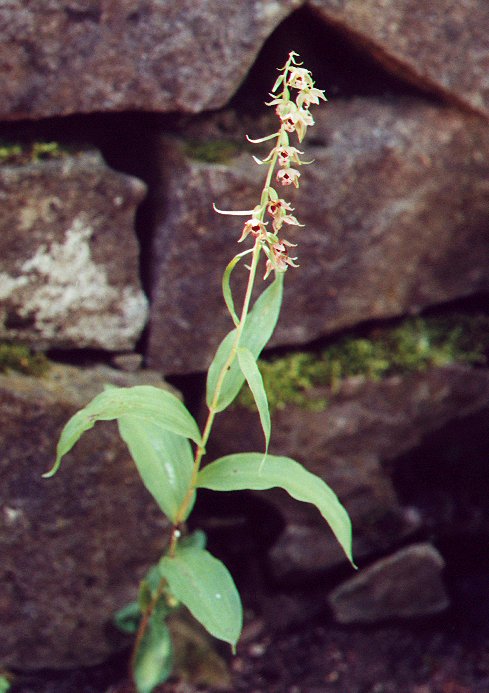Epipactis helleborine (L.) Crantz
Helleborine

Introduced
CC = *
CW = 5
MOC = 2
© DETenaglia
Epipactis helleborine (L.) CrantzHelleborine | |
 |
Introduced CC = * CW = 5 MOC = 2 |
© DETenaglia |
|
Family - Orchidaceae Stems - To +50cm tall including flowering spike, simple, erect, herbaceous, tomentose with some arachnoid pubescence above, from thin rhizomes and fibrous roots. Hairs branched, translucent, clavate or crinkled. Leaves - Alternate(spirally arranged), sessile, oblong-ovate to oblong-lanceolate, mostly glabrous, acuminate, to +11cm long, +3cm broad. Margins minutely denticulate, slightly undulate or sinuous.
Inflorescence - Terminal one-sided spikiform raceme to 30cm long(tall). Flowers subtended by linear lanceolate bracts. Bracts glabrous and with minute denticulate margins, reduced upward. Pedicels to 4mm long, pubescent. Flowers nodding. Flowers - Petals 3. Lateral 2 petals with more pinkish coloring and shorter than sepals, to 8mm long, ovate. Lower petal(lip) cupped, nectariferous, and with expanded limb at apex, crimson internally. Limb 5mm broad, 4mm long. Flora tube(ovary) to 9mm long, sparse pubescent, 6-nerved. Sepals 3, greenish-pink, lanceolate, to +1.2cm long, with green midvein, glabrous.
Flowering - June - September. Habitat - Bluffs, open rocky woods. Origin - Native to Europe, Asia, and north Africa. Other info. - This orchid was originally brought to the U.S. as a medicinal plant. It has since escaped and can be found scattered throughout the eastern half of the U.S. The plant is rare in Missouri but will probably become more frequent as the state has ideal habitat for the plant. It was originally collected in this state in 1928 and again in 1938. Photographs taken at Whirlpool State Park, Niagra Falls, NY., 8-4-00. |